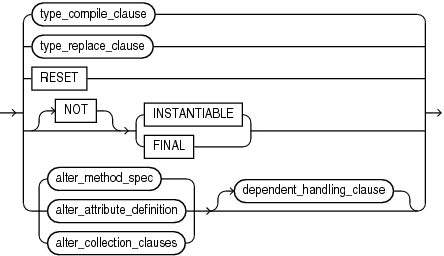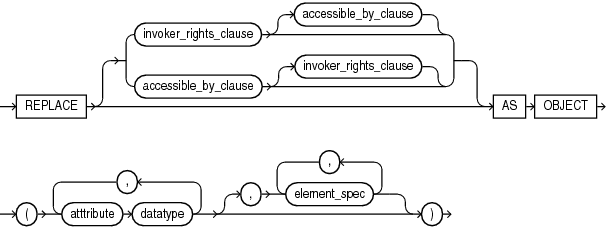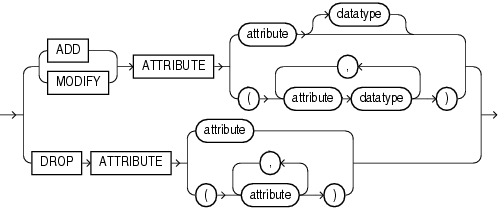14.6 ALTER TYPE Statement
Use the ALTER TYPE statement to add or drop member attributes or methods. You can change the existing properties of an object type, and you can modify the scalar attributes of the type. You can also use this statement to recompile the specification or body of the type or to change the specification of an object type by adding new object member subprogram specifications.
The ALTER TYPE statement does one of the following to a type that was created with "CREATE TYPE Statement" and "CREATE TYPE BODY Statement":
-
Evolves the type; that is, adds or drops member attributes or methods.
For more information about type evolution, see Oracle Database Object-Relational Developer's Guide.
-
Changes the specification of the type by adding object member subprogram specifications.
-
Recompiles the specification or body of the type.
-
Resets the version of the type to 1, so that it is no longer considered to be evolved.
Topics
Prerequisites
If the type is in the SYS schema, you must be connected as SYSDBA. Otherwise, the type must be in your schema and you must have CREATE TYPE or CREATE ANY TYPE system privilege, or you must have ALTER ANY TYPE system privileges.
Syntax
alter_type ::=
alter_type_clause ::=
( type_compile_clause ::=, type_replace_clause ::=, alter_attribute_definition ::=, alter_method_spec ::=, alter_collections_clauses::=, dependent_handling_clause ::= )
type_compile_clause ::=
type_replace_clause ::=
( accessible_by_clause ::=, invoker_rights_clause ::=, element_spec ::=)
alter_method_spec ::=
alter_attribute_definition ::=
alter_collections_clauses::=
dependent_handling_clause ::=
exceptions_clause ::=
Semantics
alter_type
schema
Name of the schema containing the type. Default: your schema.
type_name
Name of an ADT, VARRAY type, or nested table type.
Restriction on type_name
You cannot evolve an editioned ADT.
The ALTER TYPE statement fails with ORA-22348 if either of the following is true:
-
The type is an editioned ADT and the
ALTERTYPEstatement has notype_compile_clause.(You can use the
ALTERTYPEstatement to recompile an editioned object type, but not for any other purpose.) -
The type has a dependent that is an editioned ADT and the
ALTERTYPEstatement has aCASCADEclause.
An editioned object is a schema object that has an editionable object type and was created by a user for whom editions are enabled.
{ EDITIONABLE | NONEDITIONABLE }
Specifies whether the type becomes an editioned or noneditioned object if editioning is later enabled for the schema object type TYPE in schema. Default: EDITIONABLE. For information about altering editioned and noneditioned objects, see Oracle Database Development Guide.
alter_type_clause
RESET
Resets the version of this type to 1, so that it is no longer considered to be evolved.
Note:
Resetting the version of this type to 1 invalidates all of its dependents.
RESET is intended for evolved ADTs that are preventing their owners from being editions-enabled. For information about enabling editions for users, see Oracle Database Development Guide.
To see the version number of an ADT, select VERSION# from the static data dictionary view *_TYPE_VERSIONS. For example:
SELECT Version# FROM DBA_TYPE_VERSIONS WHERE Owner = schema AND Name = 'type_name' AND Type = 'TYPE'
For an evolved ADT, the preceding query returns multiple rows with different version numbers. RESET deletes every row whose version number is less than the maximum version number, and resets the version number of the remaining rows to 1.
Restriction on RESET
You cannot specify RESET if the type has any table dependents (direct or indirect).
[NOT] INSTANTIABLE
Specify INSTANTIABLE if object instances of this type can be constructed.
Specify NOT INSTANTIABLE if no constructor (default or user-defined) exists for this type. You must specify these keywords for any type with noninstantiable methods and for any type that has no attributes (either inherited or specified in this statement).
Restriction on NOT INSTANTIABLE
You cannot change a user-defined type from INSTANTIABLE to NOT INSTANTIABLE if the type has any table dependents.
[NOT] FINAL
Specify FINAL if no further subtypes can be created for this type.
Specify NOT FINAL if further subtypes can be created under this type.
If you change the property from FINAL to NOT FINAL, or the reverse, then you must specify the CASCADE clause of the "dependent_handling_clause" to convert data in dependent columns and tables. Specifically:
-
If you change a type from
NOTFINALtoFINAL, then you must specifyCASCADE[INCLUDINGTABLEDATA]. You cannot defer data conversion withCASCADENOTINCLUDINGTABLEDATA. -
If you change a type from
FINALtoNOTFINAL, then:-
Specify
CASCADEINCLUDINGTABLEDATAif you want to create substitutable tables and columns of that type, but you are not concerned about the substitutability of the existing dependent tables and columns.The database marks all existing dependent columns and tables
NOTSUBSTITUTABLEATALLLEVELS, so you cannot insert the subtype instances of the altered type into these existing columns and tables. -
Specify
CASCADECONVERTTOSUBSTITUTABLEif you want to create substitutable tables and columns of the type and also store subtype instances of the altered type in existing dependent tables and columns.The database marks all existing dependent columns and tables
SUBSTITUTABLEATALLLEVELSexcept those that are explicitly markedNOTSUBSTITUTABLEATALLLEVELS.See Also:
Oracle Database Object-Relational Developer's Guide for a full discussion of ADT evolution
-
Restriction on FINAL
You cannot change a user-defined type from NOT FINAL to FINAL if the type has any subtypes.
type_compile_clause
(Default) Recompiles the type specification and body.
See compile_clause and compiler_parameters_clause semantics.type_replace_clause
Starting with Oracle Database 12c Release 2 (12.2), thetype_replace_clause is deprecated. Use the alter_method_spec clause instead. Alternatively, you can recreate the type using the CREATE OR REPLACE TYPE statement.
Adds member subprogram specifications.
Restriction on type_replace_clause
This clause is valid only for ADTs, not for nested tables or varrays.
attribute
Name of an object attribute. Attributes are data items with a name and a type specifier that form the structure of the object.
element_spec
Specifies elements of the redefined object.
alter_method_spec
Adds a method to or drops a method from the type. The database disables any function-based indexes that depend on the type.
In one ALTER TYPE statement you can add or drop multiple methods, but you can reference each method only once.
ADD
When you add a method, its name must not conflict with any existing attributes in its type hierarchy.
DROP
When you drop a method, the database removes the method from the target type.
Restriction on DROP
You cannot drop from a subtype a method inherited from its supertype. Instead you must drop the method from the supertype.
alter_attribute_definition
Adds, drops, or modifies an attribute of an ADT. In one ALTER TYPE statement, you can add, drop, or modify multiple member attributes or methods, but you can reference each attribute or method only once.
ADD ATTRIBUTE
Name of the attribute must not conflict with existing attributes or methods in the type hierarchy. The database adds the attribute to the end of the locally defined attribute list.
If you add the attribute to a supertype, then it is inherited by all of its subtypes. In subtypes, inherited attributes always precede declared attributes. Therefore, you might need to update the mappings of the implicitly altered subtypes after adding an attribute to a supertype.
DROP ATTRIBUTE
When you drop an attribute from a type, the database drops the column corresponding to the dropped attribute and any indexes, statistics, and constraints referencing the dropped attribute.
You need not specify the data type of the attribute you are dropping.
Restrictions on DROP ATTRIBUTE
-
You cannot drop an attribute inherited from a supertype. Instead you must drop the attribute from the supertype.
-
You cannot drop an attribute that is part of a partitioning, subpartitioning, or cluster key.
Caution:
If you use the
INVALIDATEoption, then the compiler does not check dependents; therefore, this rule is not enforced. However, dropping such an attribute leaves the table in an unusable state. -
You cannot drop an attribute of a primary-key-based object identifier of an object table or a primary key of an index-organized table.
-
You cannot drop all of the attributes of a root type. Instead you must drop the type. However, you can drop all of the locally declared attributes of a subtype.
MODIFY ATTRIBUTE
Modifies the data type of an existing scalar attribute. For example, you can increase the length of a VARCHAR2 or RAW attribute, or you can increase the precision or scale of a numeric attribute.
Restriction on MODIFY ATTRIBUTE
You cannot expand the size of an attribute referenced in a function-based index, domain index, or cluster key.
alter_collection_clauses
These clauses are valid only for collection types.
MODIFY LIMIT integer
Increases the number of elements in a varray. It is not valid for nested tables. Specify an integer greater than the current maximum number of elements in the varray.
MODIFY ELEMENT TYPE datatype
Increases the precision, size, or length of a scalar data type of a varray or nested table. This clause is not valid for collections of ADTs.
-
For a collection of
NUMBER, you can increase the precision or scale. -
For a collection of
RAW, you can increase the maximum size. -
For a collection of
VARCHAR2orNVARCHAR2, you can increase the maximum length.
dependent_handling_clause
Specifies how the database is to handle objects that are dependent on the modified type. If you omit this clause, then the ALTER TYPE statement terminates if the type has any dependent type or table.
INVALIDATE
Invalidates all dependent objects without any checking mechanism. Starting with Oracle Database 12c Release 2 (12.2), the INVALIDATE command is deprecated. Oracle recommends that you use the CASCADE clause instead.
Caution:
The database does not validate the type change, so use this clause with caution. For example, if you drop an attribute that is a partitioning or cluster key, then the table becomes unusable.
CASCADE
Propagates the type change to dependent types and tables. The database terminates the statement if any errors are found in the dependent types or tables unless you also specify FORCE.
If you change the property of the type between FINAL and NOT FINAL, then you must specify this clause to convert data in dependent columns and tables.
INCLUDING TABLE DATA
(Default) Converts data stored in all user-defined columns to the most recent version of the column type.
Note:
You must specify this clause if your column data is in Oracle database version 8.0 image format. This clause is also required if you are changing the type property between FINAL and NOT FINAL
-
For each attribute added to the column type, the database adds an attribute to the data and initializes it to null.
-
For each attribute dropped from the referenced type, the database removes the corresponding attribute data from each row in the table.
If you specify INCLUDING TABLE DATA, then all of the tablespaces containing the table data must be in read/write mode.
If you specify NOT INCLUDING TABLE DATA, then the database upgrades the metadata of the column to reflect the changes to the type but does not scan the dependent column and update the data as part of this ALTER TYPE statement. However, the dependent column data remains accessible, and the results of subsequent queries of the data reflect the type modifications.
CONVERT TO SUBSTITUTABLE
Specify this clause if you are changing the type from FINAL to NOT FINAL and you want to create substitutable tables and columns of the type and also store subtype instances of the altered type in existing dependent tables and columns.
exceptions_clause
FORCE
Specify FORCE if you want the database to ignore the errors from dependent tables and indexes and log all errors in the specified exception table. The exception table must have been created by running the DBMS_UTILITY.CREATE_ALTER_TYPE_ERROR_TABLE procedure.
Examples
See "CREATE TYPE Statement" for examples creating the types referenced in these examples.
Example 14-7 Adding a Member Function
This example uses the ADT data_typ1.
A method is added to data_typ1 and its type body is modified to correspond. The date formats are consistent with the order_date column of the oe.orders sample table.
ALTER TYPE data_typ1
ADD MEMBER FUNCTION qtr(der_qtr DATE)
RETURN CHAR CASCADE;
CREATE OR REPLACE TYPE BODY data_typ1 IS
MEMBER FUNCTION prod (invent NUMBER) RETURN NUMBER IS
BEGIN
RETURN (year + invent);
END;
MEMBER FUNCTION qtr(der_qtr DATE) RETURN CHAR IS
BEGIN
IF (der_qtr < TO_DATE('01-APR', 'DD-MON')) THEN
RETURN 'FIRST';
ELSIF (der_qtr < TO_DATE('01-JUL', 'DD-MON')) THEN
RETURN 'SECOND';
ELSIF (der_qtr < TO_DATE('01-OCT', 'DD-MON')) THEN
RETURN 'THIRD';
ELSE
RETURN 'FOURTH';
END IF;
END;
END;
/Example 14-8 Adding a Collection Attribute
This example adds the author attribute to the textdoc_tab object column of the text table.
CREATE TABLE text ( doc_id NUMBER, description textdoc_tab) NESTED TABLE description STORE AS text_store; ALTER TYPE textdoc_typ ADD ATTRIBUTE (author VARCHAR2) CASCADE;
The CASCADE keyword is required because both the textdoc_tab and text table are dependent on the textdoc_typ type.
Example 14-9 Increasing the Number of Elements of a Collection Type
This example increases the maximum number of elements in the varray phone_list_typ_demo.
ALTER TYPE phone_list_typ_demo MODIFY LIMIT 10 CASCADE;
Example 14-10 Increasing the Length of a Collection Type
This example increases the length of the varray element type phone_list_typ.
ALTER TYPE phone_list_typ MODIFY ELEMENT TYPE VARCHAR(64) CASCADE;
Example 14-11 Recompiling a Type
This example recompiles type cust_address_typ in the hr schema.
ALTER TYPE cust_address_typ2 COMPILE;
Example 14-12 Recompiling a Type Specification
This example compiles the type specification of link2.
CREATE TYPE link1 AS OBJECT (a NUMBER); / CREATE TYPE link2 AS OBJECT (a NUMBER, b link1, MEMBER FUNCTION p(c1 NUMBER) RETURN NUMBER); / CREATE TYPE BODY link2 AS MEMBER FUNCTION p(c1 NUMBER) RETURN NUMBER IS BEGIN dbms_output.put_line(c1); RETURN c1; END; END; /
In this example, both the specification and body of link2 are invalidated because link1, which is an attribute of link2, is altered.
ALTER TYPE link1 ADD ATTRIBUTE (b NUMBER) INVALIDATE;
You must recompile the type by recompiling the specification and body in separate statements:
ALTER TYPE link2 COMPILE SPECIFICATION;
ALTER TYPE link2 COMPILE BODY;
Alternatively, you can compile both specification and body at the same time:
ALTER TYPE link2 COMPILE;
Example 14-13 Evolving and Resetting an ADT
This example creates an ADT in the schema Usr, evolves that ADT, and then tries to enable editions for Usr, which fails.
Then the example resets the version of the ADT to 1 and succeeds in enabling editions for Usr. To show the version numbers of the newly created, evolved, and reset ADT, the example uses the static data dictionary view DBA_TYPE_VERSIONS.
-- Create ADT in schema Usr: create type Usr.My_ADT authid Definer is object(a1 number) -- Show version number of ADT: select Version#||Chr(10)||Text t from DBA_Type_Versions where Owner = 'USR' and Type_Name = 'MY_ADT' /
Result:
T -------------------------------------------------------------------------------- 1 type My_ADT authid Definer is object(a1 number) 1 row selected. -- Evolve ADT: alter type Usr.My_ADT add attribute (a2 number) / -- Show version number of evolved ADT: select Version#||Chr(10)||Text t from DBA_Type_Versions where Owner = 'USR' and Type_Name = 'MY_ADT' /
Result:
T -------------------------------------------------------------------------------- 1 type My_ADT authid Definer is object(a1 number) 2 type My_ADT authid Definer is object(a1 number) 2 alter type My_ADT add attribute (a2 number) 3 rows selected. -- Try to enable editions for Usr: alter user Usr enable editions /
Result:
alter user Usr enable editions * ERROR at line 1: ORA-38820: user has evolved object type -- Reset version of ADT to 1: alter type Usr.My_ADT reset / -- Show version number of reset ADT: select Version#||Chr(10)||Text t from DBA_Type_Versions where Owner = 'USR' and Type_Name = 'MY_ADT' /
Result:
T -------------------------------------------------------------------------------- 1 type My_ADT authid Definer is object(a1 number) 1 alter type My_ADT add attribute (a2 number) 2 rows selected. -- Try to enable editions for Usr: alter user Usr enable editions /
Result:
User altered.Related Topics
In this chapter:
In other books:
-
Oracle Database Development Guide for more information about editions
-
Oracle Database Development Guide for more information about pragmas
-
Oracle Database Object-Relational Developer's Guide for more information about the implications of not including table data when modifying type attribute








